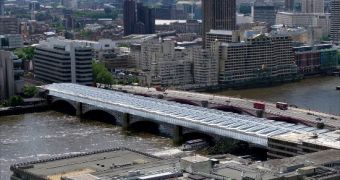The city of London in the United Kingdom can now take pride in the fact that it is home to the world's largest solar bridge. Thus, the last of the 4,400 planned photovoltaic panels have been installed, and Network Rail cut the ribbon on the resulting installation just yesterday.
On its website, Solar Century, i.e. the company in charge of implementing this project, details that the solar bridge was set in place as part of Network Rail's plans to upgrade London's Blackfriars station.
Specifically, Network Rail expanded into Blackfriars Bridge across the River Thames, and erected a roof for the construction.
It is on this roof that the 4,400 photovoltaic panels, whose combined surface amounts to over 6,000 square meters (about 64,583 square feet), now rest.
Businesses Green tells us that the electricity produced by the installation will serve to power the Blackfriars station. Thus, the facility is expected to have roughly 50% of its power demand met by energy provided by the solar bridge.
Specialists estimate that, over the course of just one year, having this much green energy pumped into said station will help reduce carbon emissions by about 511 tonnes.
Talking to members of the press, David Statham, currently working as a managing director for First Capital Connect, i.e. the company that operates London's Blackfriars station, stated as follows:
“Electric trains are already the greenest form of public transport - this roof gives our passengers an even more sustainable journey. The distinctive roof has also turned our station into an iconic landmark visible for miles along the River Thames.”
“The fact that it's so visual is a real bonus. I think as a statement, London often tries to be a sustainable city and I think it's great from that point of view,” added Suzanna Lashford with Solar Century.
Work on this solar bridge took about two years to complete. Solar Century explains that the photovoltaic panels had to be installed in several phases, and that workers only took a break during the 2012 Olympic Games.

 14 DAY TRIAL //
14 DAY TRIAL //